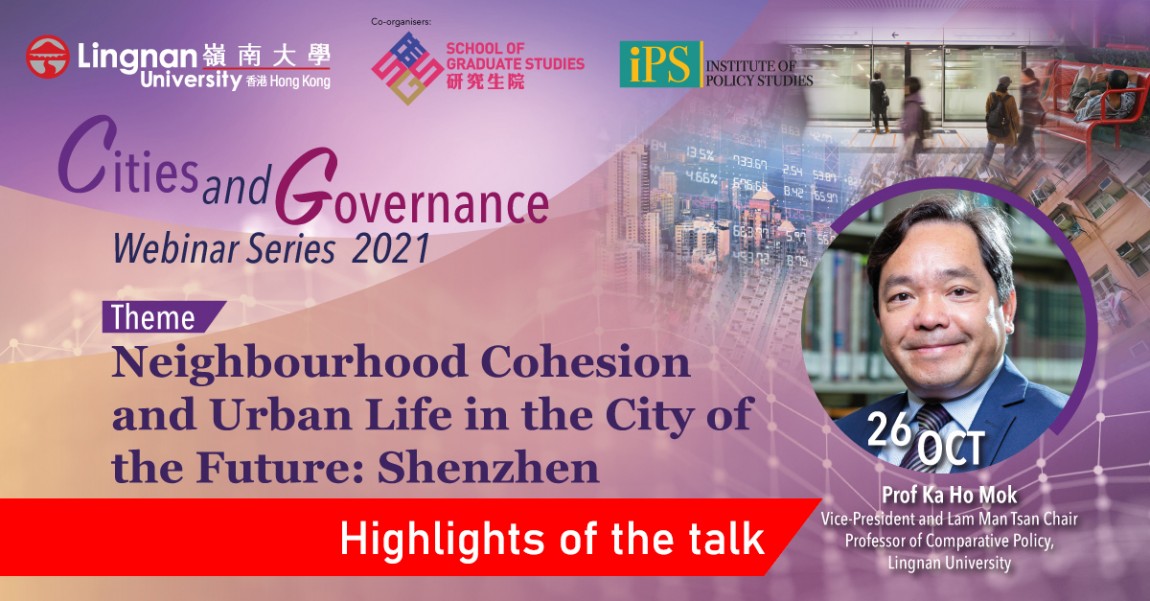Can neighbourhoods coalesce in a city that is only 40 years old?

In 1980, Shenzhen was a simple fishing village on the coast of Guangdong, minuscule compared to neighbouring Hong Kong. During the four decades since, and with the encouragement of central government, Shenzhen has transformed itself into a megacity and a national tech hub. But given this lightning-fast growth, had the city’s population had the time and the inclination to develop a sense of community?
In the third of Lingnan University Cities and Governance Webinar Series, Prof Joshua Ka Ho Mok, the University’s Vice-President and Lam Man Tsan Chair Professor of Comparative Policy, set out the results of a 2018 Lingnan study into the state of neighbourhood cohesion in Shenzhen. The team conducting that research had been led by the late Professor Ray Forrest, and Prof Mok dedicated this webinar to his memory.
Using a framework established in 2020 study by Croissant and Walkenhorst, titled ‘Indicators of social cohesion in Asia’, Prof Mok went on to assess the findings of Prof Forrest’s work. Croissant and Walkenhorst pointed to three factors that determine social cohesiveness: the extent of social relations, the level of connectedness, and the strength of people's focus on the common good.
Shenzhen and the changing face of urban life
Around 10 years ago, Beijing realised that the country’s rapid economic growth couldn’t be sustained by manufacturing alone. Spurring the innovation and technology sectors was seen as essential to ensuring future expansion. The subsequent policy shift turbo-charged Shenzhen’s already rapid development, as its digital creativity and capacity for low-cost manufacturing became even more highly valued.
“But what makes cities successful is not really the infrastructure, the hardware, the buildings,” said Prof Mok. “More importantly, it is whether the people [living in them] see them as a city of the future and whether they have a strong sense of community.”
Prof Forrest and his team were inspired by the notion that, if the nature of urban life and the levels of neighbourhood cohesion found in cities are changing, this should be most evident in a ‘city of the future’ such as Shenzhen, where recent arrivals form a large percentage of the population and so much of life can be lived online.
The survey and its findings
In 2018 the team conducted a face-to-face survey of over 1000 residents in Shenzhen's four older, inner core districts: Nanshan, Futian, Luohu and Yantian. Unlike in other first tier cities within China, where most residents own their home, 72 percent of Shenzhen’s population rent and only 21 percent are home owners.
In terms of identity, 36 percent of survey respondents saw themselves as ‘Shenzheners’, and 50 percent described themselves as temporary migrant workers. Even so, 41 percent said they had a strong sense of belonging to their neighbourhood, and 14 percent categorised this attachment as very strong. Around 50 percent said they frequently talk to their neighbours and felt they could rely on them.
The three words respondents most often used to describe life in Shenzhen were busy, stressful and expensive. Despite this when asked, if they had the option of living anywhere in the world would they still chose to live in Shenzhen, 60 percent either agreed, or strongly agreed, that they would. Around 75% percent of those surveyed said they either agreed or strongly agreed with the idea that Shenzhen was a city of the future.
When asked to name the most important criteria for a good quality of life, the top three factors named were: air quality by 79 percent; income by 71 percent; and, friends and family by 35 percent
And as for what would make Shenzhen feel more like home, the most popular choices were owning property, cited by over 45 percent, and gaining official household registration, mentioned by over 25 percent.
Implications of the survey’s findings
Even though Shenzhen has gone through a process of incredibly fast development and population growth, Prof Mok said the findings still show quite high levels of neighbourhood and social cohesion. And this is despite half of the population seeing themselves as temporary migrant workers. “I think the extent of social networks, and the trust people have in each other, is quite strong.”
Prof Mok said another factor which leads residents to make long-term plans for life in Shenzhen, notwithstanding the various challenges they face on a day-to-day basis, are the opportunities promised by its future development.
He pointed out that the research findings had important implications for all the cities within the Greater Bay Area, including Hong Kong. He noted that, to ensure success, these cities will need to work together to build a spirit of trust and confidence.
The experience of a number of cities around the world, particularly in Europe, has shown the benefits of adopting more participative modes of democratic engagement and accountability. “Then citizens see themselves as part of the city, and identify with it.”
If they identify with a community, if they identify with a city, they are not simply concerned with their own interests, but can make a much more effective contribution to the community and to the city’s success.

